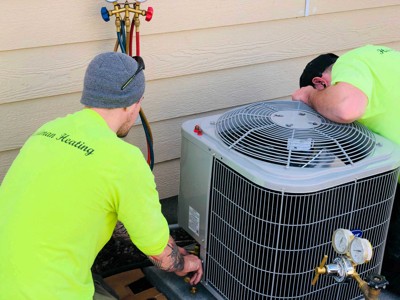If you have been curious to learn how to replace capacitor on AC unit, you have come to the right place. Your AC’s outdoor unit houses one of the essential parts of the system, the air conditioner capacitor.
Homeowners frequently replace the AC capacitor because the HVAC will not function without it. To replace, you first must turn off the power supply to avoid fatal electricity shocks. You will then remove the access panel and install the new capacitor.
Hiring an AC expert to replace the capacitor will cost you about $300 to $400, while doing it yourself could cost you $20-$50. However, although they are easy and cheap to replace, AC capacitors are dangerous because of the high voltage. Therefore, get an expert’s guidance and read the user’s manual keenly.
What Is A Capacitor, And What Does It Do?
The AC’s capacitor is the source of electricity for the air conditioner’s motors. It stores power and sends it to the motors to start the cooling cycle. When the system runs, there is less energy output in the capacitor, but the current supply continues until the end of the cycle.
You can know how your capacitor is functioning by measuring the voltage. It shows how much electrical current is moving through the part. For example, a high voltage indicates a fast electrical current.
The AC capacitors are essential because they boost the AC to work effectively. This is because air conditioners are high-powered machines that need much power to function.
Since the AC capacitor works hard to ensure the correct functioning of the system, it is more likely to fail. An ineffective capacitor leads to a malfunctioning air conditioner, which could reduce your home’s comfort.
Before looking at how to replace capacitor on AC unit, we first need to know the signs that it is failing.
Signs AC Capacitor Is Faulty
Old AC capacitors wear down and cannot hold a charge, making the air conditioning ineffective. Another reason your AC capacitor is not functioning well is damage from heavy power surges. If you suspect damage, look for these signs.
1. Clicking Sound
A common way to know that your capacitor is wearing out is a clicking sound within the cabinet. You should replace the part almost immediately because leaving it to shut down completely could burn out the motor.
2. Humming Sound On Your Air Conditioner
The AC capacitor helps to start the air conditioner motor. If it cannot function, the AC motor will try to switch on but fail. It instead produces a humming sound, which is easy to notice. To keep your AC running effectively, you should replace the capacitor.
3. Delays in Turning on the Air Conditioner
When the capacitor is weak, it struggles to start the air conditioner. Your system will take time to turn on but shut down almost immediately. The problem could be the capacitor which needs to get replaced immediately.
How to Replace AC Capacitor
Once you spot any signs of damage on your capacitor, you can replace it immediately. You will require simple tools and materials to open your outdoor unit, remove the current device and install the new one.
Before beginning the replacement process, remember that AC capacitors store electricity, so you must handle it carefully. Poor handling of the capacitor can lead to electric shocks.
These step-by-step instructions will help you replace your AC capacitor effortlessly.
1. Turn OFF the Main Power Supply
When learning how to replace the AC capacitor, the first step is turning off the main power supply to stop the current from flowing. Next, look for a circuit breaker near the outdoor air conditioner unit and ensure it is off.
If you cannot see the circuit breaker, you can completely shut down the electricity from the main power box. Ensure the thermostat is also in the OFF position to prevent low-voltage currents from going to the capacitor.
2. Open the Access Panel
Use a nut driver to remove the mounting screws securing the access panel. This panel is mainly at the upper corner of the conditioner’s casing. Ensure you keep the screws safe because you will use them after replacing the capacitor.
3. Examine the Old Capacitor
Once you open the access panel, you can see the old capacitor. It looks like a can, and it has writings on the sides. Note the load voltage indicated, tolerance, and capacitance.
When buying a new capacitor, ensure you get one with the same exact load voltage as the previous voltage. Although you could get it slightly different in shape, it is not a cause for an alarm.
Before removing the old capacitor, discharge it to eliminate any electricity stored. Next, get an insulated screwdriver and hold it across two metal terminals. The terminals must extend from the capacitor body to short-circuit and release any stored electricity.
Check the old capacitor to see where you will fix the wires. Then, mark the cables with tape to know the terminal it was attached to, and detach the capacitor by unscrewing the mounting strap and pulling it out of the unit.
4. Replace the Capacitor
Once the old capacitor is out, install the new one in the same spot. Connect the wires to the marked terminals to resemble the original ones and use a mounting strap to secure them.
5. Test It
Congratulations on successfully installing a new capacitor in your outdoor air conditioning unit. The last step is switching the circuit breaker to test if it works correctly.
Once the circuit breaker is on, please turn on the thermostat and set it to low temperatures. If there are no changes, check if you attached the wires correctly. Remember first to switch off the power to check the wiring. If the system works well after the replacement, install the access cover and secure it with screws.
Final Words
Knowing how to replace the capacitor on the AC unit is a quick and straightforward process. You require a screwdriver and knowledge of how to handle the capacitor carefully. However, if you don’t trust your skills enough, hire an AC capacitor expert to change them.






